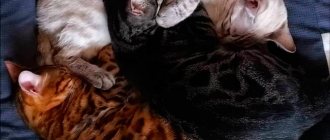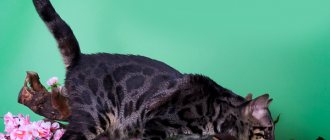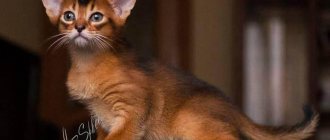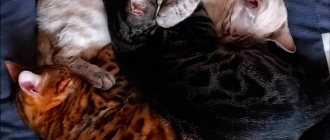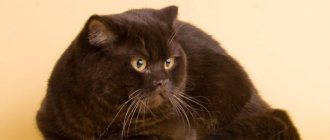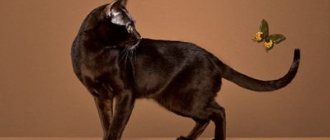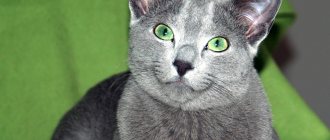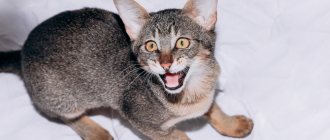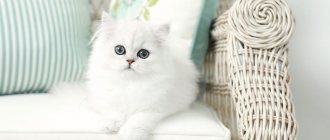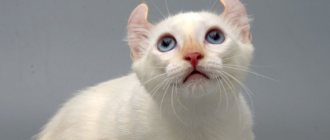The Golden Chinchilla is a cat of an original and rare color, which is most common among the British, Scots and Persians. It was bred artificially by crossing representatives of different breeds.
These animals are extremely popular and invariably win “feline beauty” competitions. But in order to find a purebred pure golden chinchilla kitten, you need to learn about its characteristics and standard requirements.
Patterned
Any color can be patterned.
The shape of the pattern is determined by a series of T (tabby) genes. And such genes are present in the genotype of absolutely every cat. But, as you know, not every cat is striped or spotted. It's all about another gene - A (agouti). This gene either “turns on” or “turns off” as the hair grows, coloring the hairs in transverse rings with alternating dark and light tones. Decoding the colors of cats begins with a search for two genes in the genotype - T and A. If there is at least one A, the cat will be patterned. If there are two aa in the genotype (homozygous recessive set), the fur coat will be colored evenly, since without ticking (coloring the fur in stripes) a pattern is impossible. So, what does the color of a tabby cat mean? The answer is obvious: the cat is a carrier of the dominant agouti gene (A). Now let's look at the tabby gene (T):
Ta (Abyssinian) is dominant to T (stripes), and T is dominant to Tb (marble). But there are still spots! But with them it’s more complicated: either there is a specific gene that allows spotting to appear, or the spots are the result of the work of a group of modifier genes that “break” the stripes (the latter is more likely).
Drawing or moire?
If the agouti gene is in a recessive form, then the animal becomes evenly colored, in other words, solid (solid), the pattern on it is also visible, but only in the form of moire. In childhood it is quite bright, but with age it practically disappears. The same effect can be observed in wild cats - small lion cubs are clearly spotted, panthers (black variations of leopards) also moirate in the bright sun. Simply put, whether a cat is tabby or a solid color does not matter, it always has some kind of pattern in its genotype, but only thanks to the manifestation of the Agouti gene does it become clearly visible.
Disadvantages: for monochromatic animals, the disadvantages are all the inherent features of patterned animals - bright residual moire, uneven coloring of the fur along the entire length, lightened basal stripe. In kittens, a veil-like pattern is acceptable, but in adult animals there should be no moire.
Eye color: For solid British people, only orange eye color is recognized.
| Black Panther (neagouti with residual moire) |
As a result of the various manifestations of a complex of polygenes that finally remove moiré from the body of animals, it is either barely noticeable or very bright, especially if we are talking about a smoky animal (i.e., silvery solid), which often misleads novice breeders. It seems to them that the animal is tebbed, when in fact it is plain, but with a strong residual moire.
It is very simple to distinguish such a false tabby from a real one; it is enough to understand that in a moired solid the “pattern” and “background” are shades of the same color, a little lighter and a little darker, while in a true tabby the pattern is not just contrasting with respect to the background, but and the background is different from the picture in color.
|
Patterned “silver” and “gold”
Patterned colors look extremely beautiful and impressive if breeders pay attention not only to improving the pattern itself, but also the background. Thanks to the work of an additional group of polygenes, the yellow-brown undercoat can be given a bright golden-sandy hue, making it “golden,” and if the patterned color is combined with the dominant Silver gene (I), then the beige tone of the undercoat changes to bright white and the result is “silver.”
A table that clearly shows how, as a result of various selections, the background shade can differ using the example of a spotted pattern
“Cold” tone of the undercoat, especially on the body, and slight yellowness on the face and paws (BRI n 24)
Bright, richly “warm” tone of the undercoat. This cat has gold in her ancestry, if not for her orange eyes, she could very well be one. (BRI n 24)
For chocolate color, the golden shade of the background is natural; the chocolate gene gives a “warm” tone not only to the main color, but also to the background. This is why it is so difficult to work with chocolate silver; it is extremely difficult to achieve a clear contrasting pattern and a clean background without yellowness
(BRI b 24)
The “warm” tone of the undercoat of this golden animal was obtained as a result of many years of work by breeders. Please note that the polygenic complex that gives the golden hue to the undercoat indirectly affects the main pigment, as a result of which the pattern on the body becomes brown instead of black. Nevertheless, genetically it is precisely black, which can be seen in the places of the greatest accumulation of pigment - the tip of the tail, paw pads, and the rim of the nose. (BRI ny 24)
| Table of Rufisms using the example of black silver spotted British cats (BRI ns 24) | |
| This cat has small rufisms on his face, chest and paws; perhaps his closest ancestors have solidi, in which selection to weed out rufisms is impossible, they do not appear on a single color. Orange eyes also indirectly indicate the presence of such ancestors. (BRI ns 24 62) | This cat is pure silver with no yellow, bred through breeding for silver over many generations. (BRI ns 24 64) |
Marble (classic, blotched/marble tabby)
It is the most recessive form of the tabby (tb) gene and the most striking of all patterned colors. On the shoulder blades there is a characteristic pattern in the form of butterfly wings, three wide stripes stretch along the back, concentric circles with a center on the sides, the tail has 2-3 wide stripes, and not many thin ones like a tiger. Ideally, the pattern should be thick and clear, contrasting with the main background. It has a modification - marble, which differs from the classic one in that it has thicker edges and a pale middle (bordered).
List of cat genes responsible for mutations of ears, tails and paws
| № | ( or ) | Comments | |
| 1 | FdFd | lop-eared | in addition to ear deformation in cats, the allele causes osteochondrodysplasia |
| 2 | Fdfd | lop-eared | healthy animal |
| 3 | Cu- | ears rolled back | |
| 4 | MM | embryo death | that's all |
| 5 | mm | no tail or bob tail | -//- |
| 6 | btbt | bob ponytail | only |
| 7 | kk | wedge-shaped vertebrae | believed to be responsible for deformed tails in cats, and |
| 8 | MkMk | the embryo does not develop | only munchkin and other dwarves |
| 9 | Mkmk | short legs | -//- |
Note: the genetics of the tails of all bobtails except the Japanese are unknown, presumably bob tails are inherited polygenically; The American Ringtail's tail is probably determined by a recessive gene (designation unknown).
List of cat genes responsible for rare mutations
| № | ( or ) | Comments | |
| 1 | sfsf | baldness around the eyes and mouth | probably the breed-forming gene of Lykoi |
| 2 | sasa | cotton wool (fine, brittle and thick) | |
| 3 | Cat- | ||
| 4 | brbr | brachyuris (short-tailed) | only for |
| 5 | Pd | (extra toes) | |
| 6 | Sh- | (fusion of toes) | |
| 7 | Rh- | (kangarooism) | extra joint (toe), short foot |
| 8 | dpdp | four ears | also leads to underbite, smaller eyes and a tendency to lethargy |
| 9 | tete\mcmc | ||
| fckfck | |||
| 10 | chch | death syndrome | |
| 11 | popo | only the first type | |
| 12 | rdgrdg | ||
| 13 | Rdy- | only in Abyssinian cats | |
| 14 | rtrt | found only in | |
| 15 | ndnd | ||
| 16 | slsl | ||
| 17 | Ga-1-\ga-2ga-2 | ||
| 18 | mpsmps | ||
| 19 | mama | ||
| 20 | splspl | ||
| 21 | hyhy | ||
| 22 | trtr | ||
| 23 | ewew | found among Burmese | |
| 24 | sptspt | found in | |
| 25 | hmahma\hmbhmb | ||
| 26 | haghag | ||
| 27 | hcehce | ||
| 28 | Ph- | ||
| 29 | hoho | ||
| 30 | tfmtfm | ||
| 31 | hcmhcm |
Shaded and chinchilla colors of the British cat
The next group of silver colors: shaded and “chinchilla” (shell).
If “smoky” colors look light, then shaded and chinchilla colors look almost white, with a characteristic “spraying” at the very tips of the hairs. In cats with a shaded color, this “spraying” occupies only a sixth of the hair, and in individuals with a chinchilla color it takes up even less – an eighth. Naturally, no one measures the length of a hair with a ruler, much less 1/6 or 1/8 of its color. And anyway, we call all such elegant pussies chinchillas. The following points should be noted regarding shaded and shell colors.
1. Both colors are coded as “smoky” colors, but with the numbers 11 – shaded and 12 – chinchilla (shell). For example, BRI ns11 – black, shaded. Outwardly, she looks white, with a black “spray”, and her paw pads, the rim of her nose and the rim of her eyes should be completely black.
2. Both colors mean that there should be no closed stripes on the limbs, tail, or chest (such stripes on the chest are called a necklace). Shaded cats should have shaded hair on the head, ears, sides, back and tail.
3. Chinchilla colors must have bright green eyes. Shaded, that is, slightly darker, have the right to have yellow (or orange) eyes. Only then the eye color coding is then added to the color coding: 62, for example, BRI ns11 62.
| British cat color shaded (Shaded) (BRI ns11) | British cat chinchilla color (Chinchilla) (BRI ns12) |
| British cat color golden shaded (BRI ny11) |
No less interesting are the golden colors (coded by the letter y, which is indicated by analogy with the letter s in the designation of “silver”). However, this is even more rare for the British breed.
The chin, belly and lower part of the tail should be painted a pale apricot color, the nose - brick, while a transition to black or dark brown is considered quite acceptable. The paw pads of animals of the color in question are black or dark brown, and their eyes are green.
British chinchilla cats look amazingly rich and elegant. Their fur is similar to a fox fur coat. The chinchilla was developed in the early 1970s. English breeder Norman Winder, who crossed the Persian chinchilla with the British shorthair. The breeder was attracted by the luxurious silver coat of the chinchilla and the power of the British. The experiment was a success: in 1973, Winder demonstrated a new breed at an exhibition, which was called British black with tipping (“spraying”). This color was recognized in 1980 in England by the board of directors of the cat lovers club.
This section of the site is designed to help you find a common language with professionals from the world of felinology: understand the designations of breeds and colors used in pedigree documents, exhibition catalogs, advertisements for the sale of kittens, as well as in live personal communication or on the Internet. Contains background information about the so-called EMS codes - the accepted coding of cat breeds and colors in European-type systems. EMS (Easy Mind System) was introduced and patented by one of the oldest phylological organizations, FIFe, and is used to identify cats by codes. The coding of each color, pattern and other characteristic features is the same for all breeds, is not based on genetic formulas, but is built logically, and therefore is easy to understand and remember. By familiarizing yourself with the accepted codes and several examples of their use, any reader will be able to speak EMS as their native language.
Each EMS code designation is structured and consists of three groups (see diagram below). The first group indicates the breed, the second - color, the third - additional characteristics: tabby pattern, eye color, tail length, etc. The second and third groups may be absent, below we will explain in which cases.
EMS breed and color coding scheme
The first group, three capital letters is the breed code. As a rule, breed codes are the same in different felinological systems, since they were originally assigned by FIFe, the ancestor of EMS. There are exceptions, for example FIFe and other associations for the British Shorthair use the BSH (British ShortHair) code, and the WCF uses the BRI code. For obvious reasons, the codes of breeds not recognized by FIFe may differ in different federations (and there are many such breeds; FIFe is a conservative organization in this regard). Although there is some uniformity here: usually the coding adopted by the organization that first recognized the breed becomes generally accepted. Even if breed codes do not coincide across different felinological organizations, for the most part, as is the case with BRI, they are intuitive. We will not list the codes of all breeds here; we will only indicate those that at different times participated in the breeding programs of the Scots and therefore can be found in their pedigrees. A complete list of breed codes can be found on the official WCF website.
EMS codes for some breeds (WCF)
EMS codes for some breeds (WCF)
| Breed code | Breed name |
| SFS | Scottish Fold (Scottish Fold) |
| SFS 71* | Scottish Shorthair (Scottish Straight) |
| SFL | Scottish Fold Longhair (Highland Fold) |
| SFL 71* | Scottish Longhair (Highland Straight) |
| BRI | British Shorthair |
| BLH | British Longhair |
| A.S.H. | American Shorthair |
| PER | Persian |
| EXO | Exotic Shorthair |
*The Scottish Straight and Highland Straight breeds are coded not with three characters, like all others, but with five.
Actually, the pair of numbers 71 is auxiliary (NN), denotes straight ears and should have been at the end of the encoding. Scottish Straight black silver ticked with green eyes would then be designated SFS ns 25 64 71, but since Straights are separated into an independent breed, the encoding 71 is added to the breed code, and the corresponding entry will look like SFS 71 ns 25 64. This is simply how it is historically in WCF Traditionally, other federations often use SCS encoding for Scottish Shorthair and SCL for Highland Straight (Scottish Longhair). The breed code is followed by a color code consisting of one or more lowercase letters. Since, according to the breed standard, any recognized colors are acceptable for Scots, except for color point with white, we will list them all (synonyms are indicated in parentheses after the name). You can read more about colors here.
EMS color codes
EMS color codes
| Color code | Color name |
| a | Blue (blue) |
| b | Chocolate (brown, Havana) |
| c | Lilac (lavender) |
| d | Red |
| e | Cream |
| f | Tortoiseshell (black tortoiseshell) |
| g | Blue cream (blue tortoiseshell) |
| h | Chocolate turtle |
| j | Lilac tortoiseshell |
| m* | Lightness modifier |
| n | Black (seal, sable, wild) |
| o | Cinnamon (red-brown, sorrel) |
| p | Faun (tan, beige, fawn) |
| q | Red-brown (cinnamon) tortoiseshell |
| r | Tan (fawn) tortoiseshell |
| s | Silver |
| t** | Amber |
| w | White |
| y | Gold |
*The group of so-called modified-bleached colors is not yet recognized in any breed, but EMS codes for it have already been accepted: am, cm, pm - caramel, and “em” - apricot, modified bleached blue, lilac, fawn and cream, respectively .
**The amber color group is recognized only in the Norwegian Forest Cat (NFO) breed and currently includes four colors: nt and at - amber and light amber, ft and gt - amber tortoise and light amber tortoise, as well as their variations with silver; in addition, dt and et codes are used to record red cats, genetic carriers of amber. The remaining third part of the encoding consists of one or more pairs of digits. The first digit in the pair indicates the type of trait being described (for example, eye color or the presence of white spots in the coat), and the second digit characterizes the trait itself.
EMS codes of additional features
EMS codes of additional features
| Code | Description |
| 0 – Presence of white in color | |
| 01 | Van (almost white cat, 90% white) |
| 02 | Harlequin (about a fifth of the cat is colored, the rest is white) |
| 03 | Bicolor (the ratio of white and colored is approximately the same) |
| 04 | Mitted (white spotting in pointing colors) |
| 05 | Snowshoe (a characteristic feature of the Snowshoe breed, white “shoes” on the paws) |
| 09 | Any other amount of white |
| 1 and 2 – Tabby drawing | |
| 11 | Shaded |
| 12 | Veiled (chinchilla) |
| 21 | Tabby – type of pattern not identified |
| 22 | Marble tabby (classic) |
| 23 | Tiger tabby (mackerel) |
| 24 | Spotted tabby (spotted) |
| 25 | Ticked tabby (Abyssinian) |
| 3 – Type of acromelanic color | |
| 31 | Burmese point (sepia) |
| 32 | Tonkin Point (mink) |
| 33 | Siamese point (color) |
| 5 – Tail length | |
| 51 | Taillessness |
| 52 | Remnant of tail, 1-2 vertebrae |
| 53 | Bob, 7-13 cm curled tail |
| 54 | Long, normal tail |
| 6 – Eye color | |
| 61 | Blue |
| 62 | Copper, orange |
| 63 | Divergence of eyes (one eye is blue, the other is in accordance with the breed standard) |
| 64 | Green |
| 65 | Eye color of Burmese cats (golden yellow) |
| 66 | Eye color of Tonkinese cats (aquamarine, bluish-green) |
| 67 | Siamese cat eye color (intense blue) |
| 7 – Ear placement | |
| 71 | Straight ears (straight) |
| 72 | Curled ears (curl) |
| 73 | Ears folded forward (fold) |
| 8 – Wool structure | |
| 81 | Long wool |
| 82 | Short hair |
| 83 | Brush (short, hard, sparse hairs) |
| 84 | Straight wool |
Examples of use and a few simple rules
SFS 71 c – Scottish Straight solid (solid, monochromatic) lilac color, SFL 71 w 63 – Highland Straight white with different eyes, SFS d 22 03 – Scottish Fold red marbled bicolor, SFL а 11 62 – Highland Fold blue silver shaded with yellow eyes, SFL ns 12 – highland fold black silver veiled (chinchilla), etc.
1The breed code is always written in capital letters, for example, RUS - Russian Blue. “non” is added to the code of an unrecognized breed separated by a space, for example, BOM non – Bombay (not recognized by FIFe). The color code is always written in lowercase letters, for example, ny - black gold. An “x” is added before the code of an unrecognized color, separated by a space, for example, x dy – red gold.
2For silver, gold, amber and modified lightened colors, “s”, “y”, “t” and “m” are added to the main color code without a space, respectively, for example, PER as - Persian blue silver, BRI ay - British blue gold, NFO at – Norwegian forest light amber, NFO ats – Norwegian forest silver light amber, SIA x am – blue-based Siamese caramel.
3 "Extra" codes are not indicated. If only one color is recognized in a breed, one variant of white distribution in color, one variant of tabby pattern, etc., it is not included in the EMS code, for example, Russian Blue is written simply RUS , not RUS a , Turkish Van cream color – TUV e , not TUV e 01 , Abyssinian wild (black) color – ABY n , not ABY n 25 , Siamese seal (black) point – SIA n , not SIA n 33 , etc.
4 Eye color must be indicated for white cats, non-pointing cats with a lot of white in color (van or harlequin), cats whose breed and color are not limited to one eye color, for example, SFS ns 11 62 - Scottish black silver shaded with yellow eyes, but SFS ns 12 - Scottish black silver chinchilla, no eye color specified, as only green is acceptable.
Some colors are characteristic only of one breed and are its “calling card”. An example of such a color, recognized exclusively in the Ragdoll breed, is “mitted”, EMS code 04. It is a combination of color point with an unusual distribution of white: white “socks” on the paws, a white chin, a white stripe on the belly and a white collar. In the photo there is a ragdoll of the “blue mitted” color – blue mitted. Since all ragdolls without exception have Siamese points in color, code 33 is not indicated in the EMS coding of ragdolls, EMS code: RAG a 04
Colors of the “black” group
The B (black) gene is responsible for the normal formation of black pigment. Under the influence of the b gene, the pigment oxidizes - a brown color is obtained. But B suppresses the action of b (capital letter - dominant, lowercase - recessive gene). Thus, BB and Bb cats look the same black, and if the kitten inherited two bb from its parents, it will be brown (rich chocolate) in color. Kittens inherit one chromosome from each parent. Therefore, when crossing individuals BB plus Bb, “chocolates” will not be born - there is nowhere to get two bb.
The bl gene oxidizes the pigment even more strongly than the b gene, resulting in a light, warm shade of brown called “cinnamon.” But b and B suppress bl, so the kitten must get bl from both parents, otherwise it will not be a cinnamon.
When the genetic codes for cat colors include D (d), we are talking about strengthening or lightening the pigment. Gene D makes the color rich and allows the pigment to be densely distributed in the fur: cat B_DD is black. The d gene “mutes” colors, forming less bright, calm shades: cat B_dd is gray. But kitten B_Dd will be black, because gene D is dominant to d and blocks it.
Kittens will turn out purple if they inherit two “weak” genes from their parents: bl (chocolate) and dd (lightening). Thus, lilac is bleached chocolate.
British red color standard
There is a uniform standard of coat quality and color for all British Shorthairs. Felinologists are trying to preserve this indigenous breed unchanged. Therefore, experts carefully monitor all experiments aimed at diversifying the colors of cats.
- The coat is short, elastic, silky. In red color, stiffer guard hair is allowed, which should not fit tightly to the body.
- Bright red British cats have an undercoat of the same shade as the main coat. Bald spots of a different color and uneven coloring are not allowed.
- The chin, tip of the tail and a small area on the belly may be slightly lighter than the base coat shade. In pedigree breeding, such a transformation is not welcomed, but at exhibitions experts are loyal to it.
Additional requirements apply to eye color, paw pads and nose:
- The pupil is always colored in honey, orange or copper tones.
- The color of the skin of the nose and pads is darker than the base color - brick, terracotta or bleached brown.
In red British cats, the tabby pattern will always be contrasting. There should be clear lines on the chest and neck. The same pattern starts from the corners of the eyes and covers the cheeks. On the paws and tail there are distinguishable encircling rings of the primary color.
Acceptable variations and deviations in British Reds
All colors containing red in the British are divided into several categories.
The first includes standard solid colors (solid). In this case, the wool will be dyed evenly along its entire length. The British acquired this color as a result of crossing with the Persian longhaired breed.
In the future, such inter-tribal unions were prohibited due to the increase in hair length, but the color was fixed and consistently transmitted with proper breeding.
The next category is red smoky, which is formed when the pigment is unevenly distributed throughout the hair. The root part remains light, only 4/5 of the length is colored.
The fur of red British cats seems evenly colored, but when moving, lighter areas of the hair are revealed, resulting in the effect of a shimmer of shades.
Another color option is silver-red, shaded. Here the wool is pigmented to 1/3 of its length, and 2/3 remains bleached. At the same time, the nose, eyes and lips of shaded red British kittens have a contrasting dark edging.
The next variety of red is the red chinchilla. The pigment appears only at the tip of the hair (1/8 of the length), and the rest of the hair is not dyed. The term “cameo” is used for British people with this coat color.
The acromelanic color-point (red-point) has a lighter shade of body, in contrast to the mask on the face, the tips of the ears, the ends of the paws and the tail.
British Red kittens can be born bicolor or particolor. This is a combination of white and red colors, which is considered traditional for many cat breeds. They differ only in the amount of white wool.
- from 30 to 50% white - bicolors;
- from 50 to 90% white - particolors;
The rarest combinations for cats of the British breed:
- Harlequins are 90% white and 10% red.
- Vans - maximum white color. Only the tail and a few markings on the head near the ears remain in red.
Golden Chinchilla Standards
For the first time, the golden chinchilla color was included in the standard of Persian cats. Now it is found in many breeds for which the silver chinchilla color is recognized.
Preference is given to cats with a uniform golden undercoat without a gray area at the roots. When the color first appeared, such animals were still used for breeding, but now they are increasingly not allowed to breed.
There is no single standard regulating the color of the golden chinchilla. Experts evaluate animals in accordance with documents approved for a specific breed by the World Cat Federation:
- British cats are stocky, massive and muscular. The head is round, with a wide skull and pronounced cheeks. The ears are small, set wide, and the tips are slightly rounded. The tail is thick and curves upward. The coat is raised, dense and short.
- Scottish - divided into fold-eared (Scottish fold) and straight-eared (straight). The first ones have small ears, the tips hanging forward. The limbs are short and thick. Straights have erect ears and can be small or medium in size. The limbs are slightly longer and lighter.
- Persian - distinguished by rectangular body lines. Legs are strong and short. The head is large, the forehead is sloping (other chinchillas have a rounded forehead).
Golden chinchillas have ears covered with dense and short fur. The eyes are very large and expressive.
Cinnamon - red tortoiseshell color in the British
Tortoiseshell coloring is common in British cats. It is formed by a harmonious combination of evenly colored red and black hairs. But in the case of ginger cats, cinnamon (cinnamon) replaces black and goes with any shade of red.
There are no strict rules regarding the size and number of spots in the British tortoiseshell cat color variety. It is genetically impossible to predict how they will lie on the wool, and therefore any arrangement is allowed.
In tri-colored British tortoiseshell cats, white is added to the two standard spot colors (red-black or cinnamon). Such animals are sometimes called patchwork animals, although this definition does not accurately describe their appearance.
Usually female kittens are born with a tortoiseshell color. However, nature sometimes experiments unsuccessfully, and cats become the owners of an additional chromosome (XXY). In this case, they are also born “turtles” and, most likely, will be infertile.
Color point
The “color point” color was originally found only in Siamese cats. However, over time it spread to other breeds, including chinchillas.
Longhair black silver veiled color point BLH ns 12 33
Black silver shaded color point BRI ns 11 33 with blue eyes
A sign of this color, regardless of whether the cat belongs to a particular breed, is blue eye color. Thus, blue-eyed cats appeared in the community of green-eyed chinchillas.
ns 11 33
ns 12 33
Colors of the “red” group
The O gene is responsible for “red” colors, from a bright almost brick shade to barely noticeable cream tones. The O gene is found only on the female chromosome, so a cat (XY) can carry only O or only O, but in the genotype of a cat (XX) there can be different combinations (OO, oo or Oo). Lowercase o is a recessive gene suppressed by O. Moreover, O is also dominant in relation to B, i.e. suppresses black colors. Thus, a cat that received the O gene from its mother will definitely be red (of course, if there is no W gene, which suppresses color). And a cat can be born red, and like this: BBOoDD (the first O suppresses B, the recessive o “cannot cope with the second B” - we get a tortoiseshell color).
If DD is adjacent to OO, the orange colors of the cats will be sunny and bright. If dd, the fur will acquire a delicate cream tone, since dd lightens not only black (B), but also red color.
VEILED BRITISH GOLDEN KITTENS
Veiled British Golden kittens are very rare, especially if they are of the good British type. Now many breeders, in pursuit of novelty in color and exclusivity, are working on breeding such rare colors of animals.
The Veiled British Golden kitten can only be born to golden parents, or to carriers of this gene. Also, the veiled color itself is easily interrupted by any other color and it is almost impossible to “return” it, so matings of such cats are planned with special responsibility, and we wait for golden veiled kittens with great trepidation.
Such golden British kittens are not cheap, but the price is justified, since it is an incomparable feeling of pride for your magnificent animal in such a rare color.
HOW TO DETERMINE VEILED NY12 COLOR?
We look at the fur around the paw pads. If there is no dark hair, color 12. Also, in some cases, a minimum amount of dark hair around the pads is allowed if all other characteristics correspond to the declared color.
Colors with white spots
White areas may appear on any colored spot. Sometimes their presence is mandatory, and in other cases it is a serious fault or even a disqualifying defect (see the standard of the specific breed).
So, white areas appear due to the action of the dominant white spotting gene S. Moreover, the white area is larger if the cat is homozygous, that is, SS. Heterozygous Ss individuals tend to be more colorful. With ss, there are no white spots at all (except for a small white area under the chin, which appears under the influence of other, “secondary” genes).
There are many modifier genes that affect the location, shape and number of white spots. Unfortunately, the genetics of cat colors does not yet provide a clear answer to the question of which genes and how they influence the degree of spotting. For this reason, working with colors such as van, harlequin and bicolor is quite difficult. It is no easier for those who strive to get perfect “socks” or an even white “mask” - even two excellent parents give birth to kittens with “tight” socks or “masks” that go beyond the desired boundaries.
spotted tabby
A color in which there are separate spots on the body, ideally clear and not merging, uniform on the sides and back. It is formed with the help of the main Tabby genes and a complex of polygenes that “tear” the pattern into separate spots. Spotted and striped colors often form multiple transitional forms, and all these options are always classified as spotted color, because the stripes tend to “tear” as the animal grows older. Therefore, spotted is the most common color among the British patterned. Marble color is less susceptible to the action of “tearing” polygenes, because this is a wider and denser pattern, so only marble that is completely torn into spots is classified as a stain, while marble that has only been slightly exposed to polygenes will look like marble. In any case, the spotted pattern clearly shows which color was used to form the spot.
| Diagram showing how brindle and merle colors are transformed into spotted colors by polygenes. |
| Various modifications of spotted color | |
| small dots based on ticked color | round polka dots based on brindle color |
| loose large stains based on marble | rosette spots based on marble |
| Modifications of marble pattern (classic and bordered) |
This is true for all patterned colors - they value the correctness and clarity of the pattern. And also, according to the standard, a patterned animal must have a warm undercoat tone, which can vary from light sand to rich beige.
| Quite a contrasting pattern. At the same time, we see an intermediate option between brindle and spotted - dotted stripes along the ridge, the spots are not located in a checkerboard pattern, but in the form of vertical broken stripes, partially turning into spots. |
| Low-contrast blurry, too light pattern, fuzzy spots, blending into the background. Often, such a pattern is obtained as a result of mating with shaded ones, it is like an intermediate option between a chinchilla and a silver tabby, I call it a “hedgehog”. |
| Table showing possible problems with the patterned color using black silver marbled pattern (BRI ns 22) as an example. | ||
| Correct clear pattern, contrasting to the light background | The pattern is tipped like the Russian Blue breed (the hairs at the end have light tips), so it looks as if it was sprinkled with powder | Veil-like, light, not deeply colored, tipped pattern. Intermediate between chinchilla and silver tabby |
ticked tabby
A color in which there is no pattern on the body, the entire body is evenly covered with ticked (i.e. striped) hairs. It is formed by the Ta gene, the most dominant of all patterned colors. In the homozygous manifestation, the ticked color lacks not only stripes on the body, but also on the tail, paws and chest; in the heterozygous form, the body is ticked without a pattern, and there are stripes on the points. Although the most dominant form of the tabby gene, it is very rare in the British breed and was introduced into it through the Abyssinian breed. There are quite old purebred breed lines where the Abyssinians have long since become a thing of the past, leaving behind such an unusual color as a gift.
Interesting facts, beliefs and signs about black Britons and more
The black breed of British cats traditionally arouses interest and curiosity. The signs accompanying these animals are diverse not only in nature, but also in geographical location.
- The black cat is the only animal that has its own holiday. It was founded by Italian cat lovers and falls on November 17th.
- “It will be unlucky if a black cat crosses the road” - this is not the common belief in all countries. Black Britons are very lucky. In England, they are endowed with positive properties, and the woman who has such a cat will always be the center of attention.
- The Irish believe that the charcoal anthracite cat brings wealth and prosperity.
- Even superstitious British sailors willingly took black cats on risky voyages. They believed that animals of this color bring good luck.
- In Russia there has always been an ambivalent attitude towards black cats. Having met them, in the old days people were baptized and cursed the evil one. But at the same time, they believed that black cats scared away thieves and guarded the house.
- Of all the breeds that have been officially registered in the world, only 22 have representatives of pure black color. The British Shorthair is one of them.
There is also an interesting observation: the population of black Britons is larger in cities than in rural areas. According to one version, this is due to the fact that black cats adapt better to urban conditions than their tabby or tortoiseshell counterparts.
Such “fatal” Britons, as a rule, are created by wealthy people, extraordinary personalities, prone to exaltation. They rarely live alone; the doors of their home are usually open to numerous guests.
It has been noticed that even the British, who are reserved and selfish by nature, show sociability in such conditions and often become the center of attention.
Genetics of the red (red) color of the British
The British Shorthair breed allows for approximately 250 different color combinations, with solid colors playing a major role. Ginger cats are not unique here, they are often found in litters and were once even quantitatively ahead of the blue-gray color that is considered traditional for the British.
All the tools of the genotype take part in the process of color formation: chromosomes and genes, alleles, loci and pigmentation.
- The main role in the formation of the red color in the British is played by the pigment pheomelanin - elongated ellipsoidal granules that reflect light in the range of red, yellow and orange shades.
- Genes are a library of hereditary data that is passed on from parents to offspring and continues the chain of ancestral connections ad infinitum.
- Alleles come in different forms that genes can take on. They are located on certain parts of the chromosomes - in the example of red British cats, this is a very important point.
- Locus is the location of a gene (allele) in an ordered list of chromosomal compounds.
There are 19 pairs of chromosomes in a cat's set. They store the hereditary instructions, and any deviation from the norm ends in an uncontrolled mutation. British redheads are not subject to this risk, as they are an ancient breed with an established genotype.
Genes and chromosomes that influence the formation of red color are distributed as follows:
- The O (orange) gene is responsible for the production of the red pigment pheomelanin in the British (and not only in them). It has only one permanent locus attached to the X chromosome, which determines the sex of the future kitten.
- The O gene exists in 3 alleles: OO (natural red), Oo (red and black tortoiseshell British), oo (red is blocked and does not cause pheomelanin pigmentation). The final example in practice means only one thing - the cat will be black.
- For ginger cats, there are 3 color combination options: OO, oo and Oo. For red British cats, only 2 options are possible - O and O, since they have one X chromosome.
- According to the laws of genetics, a British cat inherits the orange gene from its mother. Therefore, in a pair with a red mother and a blue-gray father, male kittens will definitely receive the properties of the red gene, and the female cats will be tortoiseshell, cream or blue.
All British red coats have a tabby pattern on their coats. It is formed under the influence of the A gene (agouti) and exists in two alleles: dominant A and paired homozygous aa. In the second case, agouti suppresses another important component of the genotype - the T (tabby) gene, which is responsible for the ornamentation on the fur coat.
The unique property of the red color is that aa (not agouti) has no effect on it. Therefore, all red British cats are always tabby.
The L gene is also involved in the formation of red color. Thanks to him, purebred British cats have short and thick hair.
Tabby (tabby)
Such cats have stripes of an unusual shape and a different color than the main color. The most common marks are on the forehead, for example, in the shape of the letter M, light spots on the back of the ears, a necklace on the chest, rings on the paws and tail, curls on the cheeks, eyes outlined as if with shadows.
Breeders distinguish several variants of tabby. According to the type of pattern, they are marbled (shaded), tiger (mackerel) and spotted (spotted).
There is a complex classification of Scots tabby dogs based on combined colors and shades. They are presented in the table below:
| Name | Main color | Pattern color |
| Silver | Silver | Black |
| Silver blue | Light blue, white undercoat | Mantle on muzzle, tail and sides |
| Red | Light red | Bright red |
| Brown | Copper | Black |
| Blue | Cream blue | Bright blue |
| Cream | Pale cream | Beige or dark cream |
| Cameo | White | Bright red |
Is it only cats?
There is a persistent myth that only cats can be carriers of tortoiseshell coloring - due to the fact that their sex chromosomes look like XX and make it possible for both black and red colors to appear simultaneously. It is not true. It is also not entirely true that, according to statistics, for every three thousand tortoiseshell cats, only one cat of this color is born - and that one is somehow sick, defective and practically sexless.
Tortoiseshell cat or tortoiseshell cat?
The quirks of nature are much more diverse and sophisticated than our understanding. Genetic solitaire games sometimes produce unpredictable results that are difficult to explain from a scientific point of view. For example, felinologists claim that the birth rate of tricolor cats directly depends on the region of their residence - scientists have not yet found an explanation for this phenomenon. But statistics on this matter, alas, are inaccurate—systematic studies have not yet been conducted.
Tortoiseshell cats
Contrary to popular belief, tortoiseshell - calico - cats do exist. But in order for the “female” color to appear, the cat must have a certain gene anomaly: the formula of their sex chromosome set is XXY. Such males are usually sterile, although there are exceptions.
Quite a lot of tricolor chimera cats are known. They can be anatomically and behaviorally similar to cats, practically do not mark their territory, do not react to females in heat and, accordingly, do not give birth to offspring. Calico-colored cats are more common than “tortoises”; they are usually cryptorchids - but that’s a completely different story.
Since the nineteenth century, felinologists from different countries have described many tricolor cats. Unfortunately, most of them were not only sterile, but also did not live long, since along with the genetic mutation they received various serious diseases.
Character of British pets
Representatives of the British breed belong to the category of pets with a difficult character.
- Sociable, but do not allow familiarity. You can pick up a British cat only if she is currently in the mood for it. Any violence or action against the will is regarded as an insult. The cat may proudly walk away, or it may bite.
- The Briton is not prone to active group games. He will most likely stay in a safe place and look down on all the fun.
- Very persistent in expressing their own demands. There are times when cats of this breed do not eat for a long time just because they want to change the place for their bowl.
There is a tendency towards aggression in the behavior of British Shorthairs. But it is never groundless. If the cat does not feel discomfort, then it will not terrorize the household with its bad inclinations.

